A window is an imperfect energy valve. We want 'sunshine' to brighten the interior, but we don't want UV to fade the drapes. We want 'solar heat' to warm us on cold winter days, but we don't want heat to leak back out at night. And on a hot day, we want to keep out the same radiation we welcomed on the cold winter day.So, naturally, we chose the coldest day so far this year to begin replacing our windows. Our contractor arrived early in the morning and set to work assembling the ladders and walkboards he and his assistant would need, and by the end of the day, our house's idiosyncratic learning curve had leveled out, and we had two of sixteen windows replaced.
Charlie Wing, How Your House Works
The rooms with the new windows are already considerably warmer. Old-style double hung windows have many zones of energy transmission; fault does not fall squarely on the single-paned glass or its glazing. The other main culprits include both obvious and hidden zones. In the obvious category, we have the edges around each sash. (In a double-hung window, the term "sash" refers the part of window that moves up and down. Double-hung windows have two sashes (though some people in the millwork industry have told me that they would say a window has "two sash", not "sashes") that move independently of one another.)
 |
| Old sashes, removed from window frame |
As most people with these style of windows know, when you put your hand up against the edge of a rickety old sash in a no-longer-square window, there's a good chance you'll feel wind blowing through.
In the not-so-obvious category falls the outside edge of the entire window frame. Though, in parts of our house, it's kind of obvious:
The truly hidden zone for energy transmission in these old windows, which I learned about yesterday, is inside the frame itself, where the weights hang.
I never knew how old windows worked, but I also never pondered the puzzle. I guess I just took them for granted, much like Sarah in Labyrinth took her conceptual understanding of the physical world for granted.
And much like that Sarah and the brick wall, once I looked past the window frame surface, I discovered a whole world of wonderment. Okay, maybe not a whole world of wonderment, but certainly some rusty old weights attached to a simple and neat pulley system.
One pulley for each sash is inset in the window frame on either side of the window. In a working window, unlike the one picured above, there would be rope or chain going through these to connect each sash to a weight inside the frame. When you move the sash up and then let go, it doesn't drop because the weights are chosen such that they balance the weight of the sash.
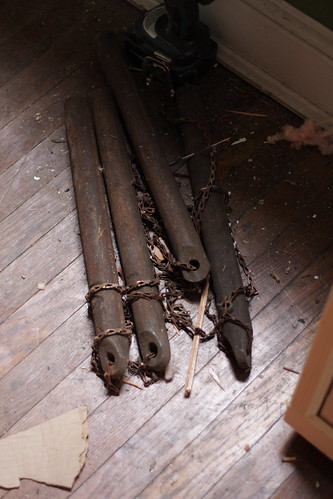 | |
| Counter-weights, two for each sash |
How much does each weigh? Well, about half that of the sash, of course! Also, in the windows in our house, we've found that the weight of each weight is stamped onto the side in roman numerals:
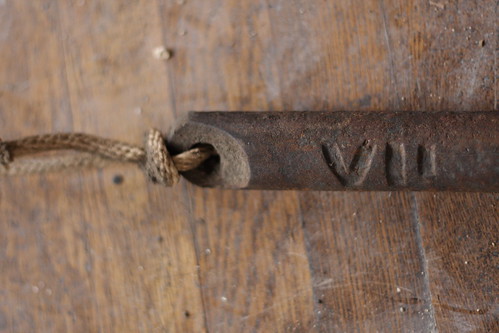 |
| I wonder if that is 7 or some clever way of writing 6.5 |
So, this part of the window where the weights hang is a fairly large cavity, enclosed by fairly thin wood, transmitting heat in and out of the house fairly well.
Of course, in addition to those three zones, our windows also had broken panes and rotting wood sashes.
The two windows that our contractor replaced yesterday were on the third floor. One in the kitchenette, and one in the front bathroom.
When I say we replaced the windows, what I really mean is that we bought "replacement" full window units that are designed to be installed inside your existing window frame. All you need to do is pop the old sashes out, put insulation in the window weight pocket, and put the new window in, and voila!
 |
| Third floor front bathroom window before and after |
After all this talk of weights and pulleys, the other window, the one in the kitchenette, is a casement. The orginal window was a double casement, that is it was like a set of miniature french doors. We replaced it with a single casement, hinged on the right and opening out. It is the only window like it that we are replacing. The other windows in the back third floor are double casements, but instead of replacing them, we plan to take them off their hinges, sand them down, and repaint them, good as new!
Here are the kitchenette window before and afters:
The two rooms with the new windows are already warmer.
For those who might, please do not worry that these old windows will in any way drive up our blog's landfill ticker. We intend to reuse the materials, so stay tuned!
Thanks for reading; I leave you with a kitchenette window installation action shot:


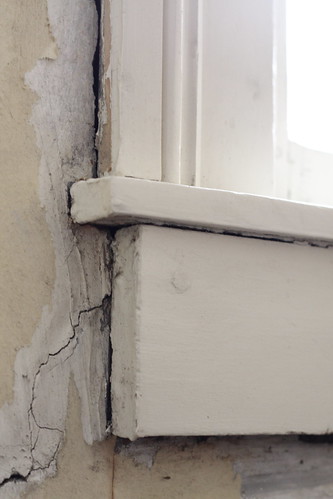
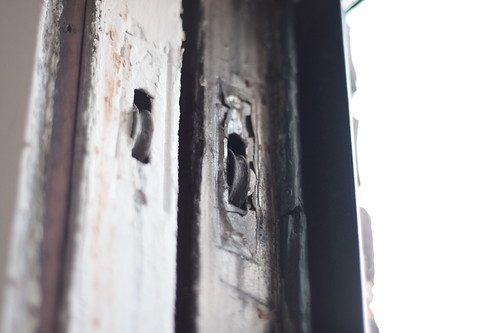
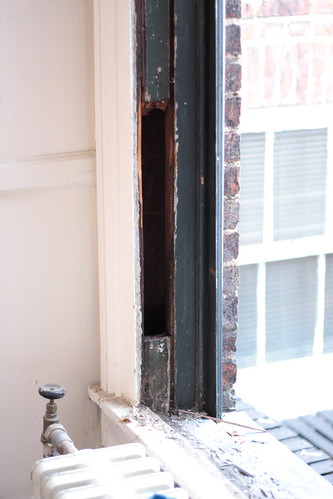




Should be a lot of expended labor there. The results, so far, look very promising. All the more emphasizing that we should keep watch of sections and corners of our homes, and try and fix the kinks as soon as possible. Because they cannot simply be left out they way they are. Mainly because it's a disorienting sight. Not for a welcoming home, I tell you. Curtains and blinds, for instance, can do wonders for windows.
ReplyDeleteRoxie @ Allure